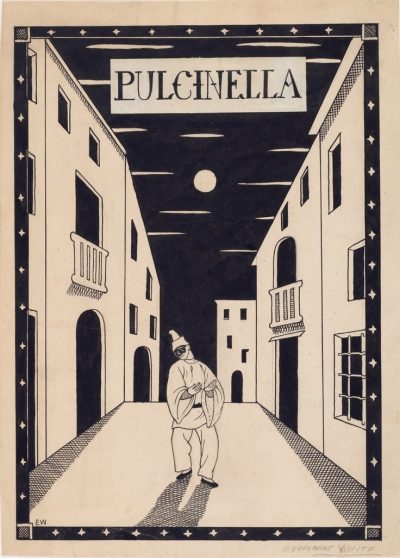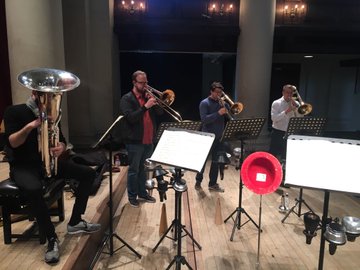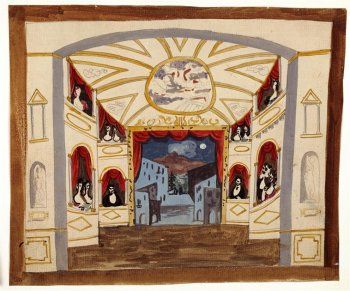Getting to grips with Pulcinella (by Huw Morgan)
Just over two months since our triumphant return from the USA, and with the group’s members all looking a little leaner as a result(!), it was back to work for our third series of Kleptomania concerts: this time, “Borrowed Baroque”. Among the programme of core brass septet classics (selections from Rameau’s Dardanus, Prokofiev’s Suite and Handel’s Rinaldo), one work stood out: Matt and Simon’s arrangement of Stravinsky’s Pulcinella Suite, the vibrant ballet music originally attributed to the 18th century Italian composer Giovanni Battista Pergolesi and orchestrated in 1920 for Serge Diaghilev’s Ballets Russes, the same Parisian company which premiered many iconic scores, including The Firebird, Petrushka, and The Rite of Spring.

A poster for Pulcinella at the Ballets Russes
Looking through any Septura piece for the first time is always an exhilarating but daunting experience, wondering how far our technical and musical limits have been stretched, and whether there’s enough space in the orchestra schedule to squeeze in the practice it undoubtedly requires before our first rehearsal. This time, however, what struck my eye was the new presentation and layout, which looked even more professional than usual, and was thanks to our recent collaboration with Dorico notation software (more of which soon, I’m sure). Unfortunately, despite the upgraded programme, our arrangers still hadn’t managed to locate the “rests button”, and as I tentatively thumbed through my part I wondered how my chops would be holding up come 9:30pm on 1st May!
Still, the great thing about Septura is that everyone knows they are in the same boat in this regard, and works their socks off to achieve the best result. Pulcinella is particularly tricky, since there’s a lot of doubling: Matt Gee with both alto and tenor trombones, Alan with trumpets in B-flat, C and D, Simon on trumpet and Flugelhorn, and me with the E-flat and B-flat piccolo. Of course, re-imagining such a vivid piece in true Septura style would not be complete without an abundance of mutes, and this work was no different. In fact, we introduced a new colour to our audiences – hat mutes – which, although conceived for jazz and big band music, veils the sound in an uniquely expressive way. A big “Dankeschön” to my colleagues in the Sinfonieorchester Basel for allowing the trumpets to borrow them for this project, and whilst the trombones are looking forward to getting their own set for our next concerts, Sasha’s desire to join in with a tuba hat might have to go unheeded (unless, of course, we can convince Matt Gee’s Dad to rig something up!)

Huw’s view of the rehearsal, featuring one of the hats!
As with our premieres of the Walton Sonata for Strings and Mussorgsky’s Pictures at an Exhibition in St. John’s Smith Square during our previous Kleptomania concerts, the frisson of excitement in tackling such a formidable work was palpable, although one particular patron did try to scupper the atmosphere by allowing his mobile phone to go off twice in the space of 10 minutes (surely that’s the dictionary definition of inexcusable?!) SJSS provides a rather generous acoustic for us brass players, and while our second venue a few days later – West Road Concert Hall in Cambridge – is always a more intimate experience for both performer and listener, it allows the clarity and virtuosity of the arrangements to come to the fore. It also offered Matt Knight a chance of redemption: after he had inimitably “humanised” our previous performance there (an event which has gone down in Septura folklore), it was a particular relief that all members, mutes, AND their instruments made it onto the platform for the second half!
Tomorrow we repeat the same programme in Champs Hill, Sussex, and this weekend we’re also revisiting Elgar, Walton and Mussorgsky in readiness for our performance on 22nd May at the Newbury Festival. And fear not: if you’d like to catch Pulcinella before the summer is out, you can hear it again on 27th June as part of the “Proms at St. Jude” in Hampstead Garden Suburb, London. In the meantime, do follow all our latest happenings here on the blog, on Facebook, or on Twitter, and if you’re attending one of our concerts, please come and say hello: we love to meet our audiences!



